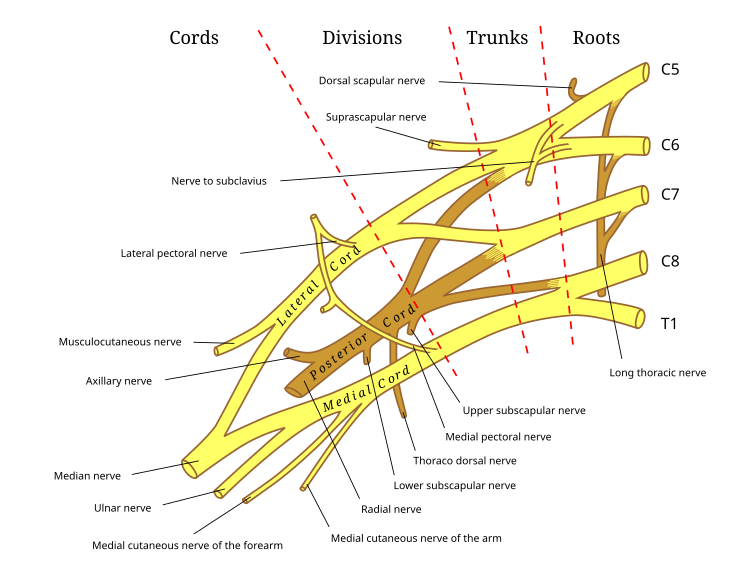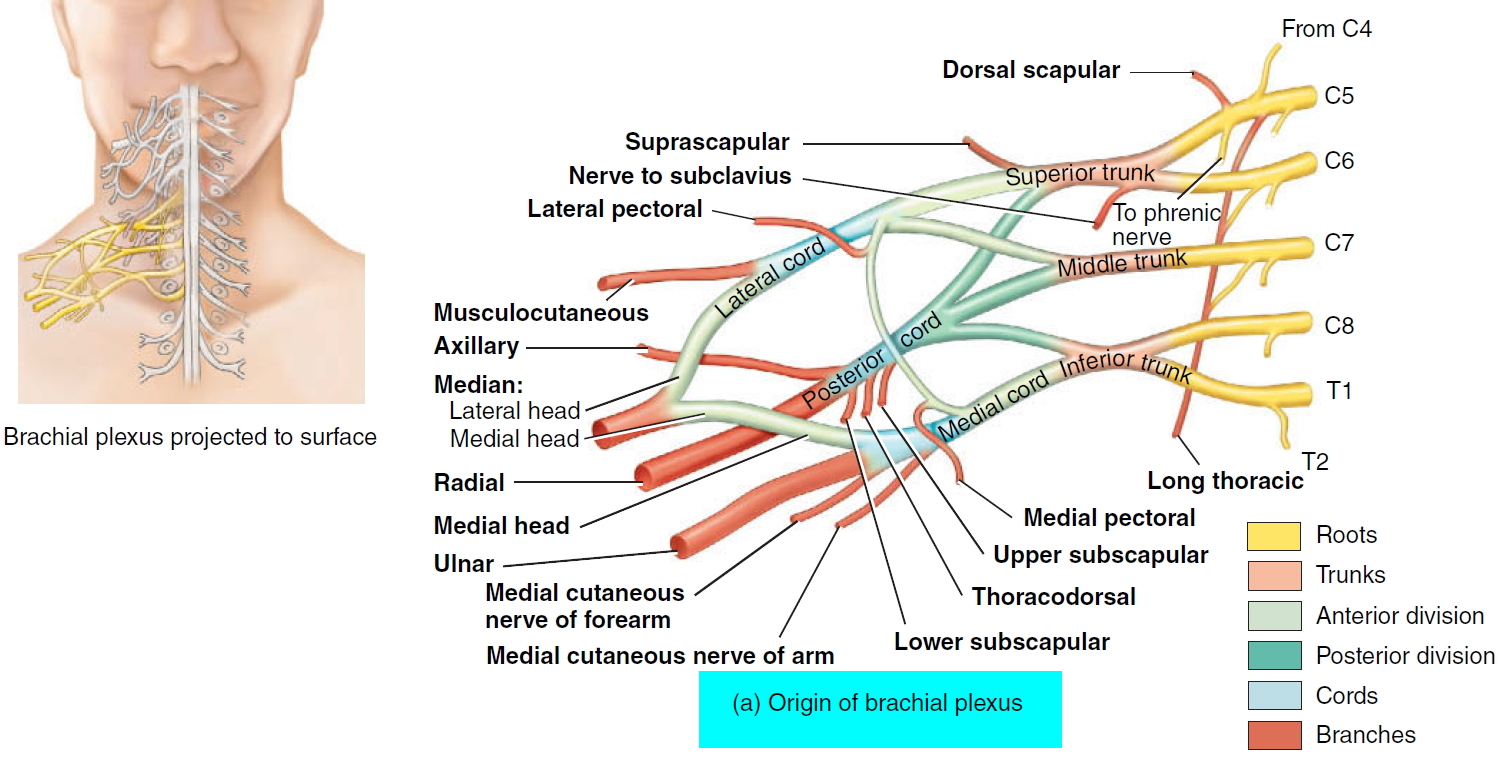The Brachial Plexus
The plexus is formed by the anterior rami (divisions) of cervical spinal nerves C5, C6, C7 and C8, and the first thoracic spinal nerve, T1.
Usually, the brachial plexus by the C5 to T1 roots with small contributions from C4 and T2. Sometimes the contribution from C4 is large, in which case the T1 root will be small and the contribution from T2 is absent. This is called the Pre-fixed brachial plexus. The contribution from C4 will be absent with a small C5 root and a large contribution from T2 is called post-fixed brachial flexus.
Since the brachial plexus lies partially in the neck and partly in the axilla, it is described in two parts, namely- 1) the supraclavicular part and 2) the infraclavicular part. To reach the axilla from the neck, the plexus passes through the cervicoaxillary canal, behind the medial part of the clavicle.
ROOTS:
The ‘roots’ refer to the anterior rami of the spinal nerves that comprise the brachial plexus. These are the anterior rami of spinal nerves C5, C6, C7, C8, and T1.TRUNK:
- The roots from C5 and C6 join to form the upper trunk of the plexus at the lateral border of the scalenus medius.
- The root from C7 continues as a middle trunk.
- The root from the C8 and T1 join to form the lower trunk behind the scalenus anterior.
DIVISION:
Each trunk divides into two branches within the posterior triangle of the neck. One division moves anteriorly (toward the front of the body) and the other posteriorly (towards the back of the body). Thus, they are known as the anterior and posterior divisions.CHORDS:
Once the anterior and posterior divisions have entered the axilla, they combine together to form three cords, named by their position relative to the axillary artery.
The lateral cord is formed by:
- The anterior division of the superior trunk
- The anterior division of the middle trunk
The posterior cord is formed by:
- The posterior division of the superior trunk
- The posterior division of the middle trunk
- The posterior division of the inferior trunk
The medial cord is formed by:
- The anterior division of the inferior trunk.
The cords give rise to the branches of the brachial plexus.
BRANCHES:
BRANCHES ARISE FROM ROOTS:
- Roots C5 gives a contribution to the phrenic nerve. The phrenic nerve descends into the thorax to supply the diaphragm.
- The dorsal scapular nerve arises from root C5.
- The long thoracic nerve of the bell is the nerve to the serratus anterior. It arises from roots C5, C6, and C7.
BRANCHES ARISE FROM TRUNKS:
- Nerve to serratus anterior
- Suprascapular nerve
BRANCHES ARISE FROM CHORDS:
- Branches of the lateral cord:
- The lateral pectoral nerve (C5-C7)
- The lateral root of the median nerve (C5-C7)
- Musculocutaneous nerve (C5-C7)
- Branches of the medial cord:
- Medial pectoral nerve (C8, T1)
- The medial root of the median nerve (C8, T1)
- The medial cutaneous nerve of arm (C8, T1)
- The medial cutaneous nerve of forearm (C8, T1)
- Ulnar nerve (C7, C8, T1)
- Branches of the posterior cord:
- Upper subscapular nerve (C5, C6)
- Lower subscapular nerve (C5, C6)
- Nerve to latissimus dorsi (thoracodorsal nerve) (C6, C7, C8)
- Axillary nerve (C5, C6)
- Radial nerve (C5-C8, T1)
Clinical Relevance:
Upper Brachial Plexus Injury (Erb’s Palsy)
Erb’s palsy refers to an injury to the upper roots of the brachial plexus (typically C5-6). It most commonly occurs as a result of a stretching injury during a difficult vaginal delivery.
- Nerves affected – the peripheral nerves derived from C5-6 roots are most affected. This includes the musculocutaneous, axillary, suprascapular, and nerve to subclavius.
- Muscles affected – supraspinatus, infraspinatus, subclavius, biceps brachii, brachialis, coracobrachialis, deltoid and teres minor.
- Motor functions affected – abduction at the shoulder, lateral rotation of the arm, supination of the forearm, and flexion at the shoulder.
- Sensory functions affected – sensation over the lateral aspect of the upper limb (C5-6 dermatomes).
The affected limb hangs limply, medially rotated by the unopposed action of the pectoralis major. The forearm is pronated due to the loss of the biceps brachii. The wrist is weakly flexed due to the normal tone of the wrist flexors relative to the weakened wrist extensors. This is position is known as ‘waiter’s tip’ and is characteristic of Erb’s palsy.
Lower Brachial Plexus Injury (Klumpke’s Palsy)
Klumpke’s palsy is an injury of the lower roots of the brachial plexus (C8-T1). It is also most commonly associated with a difficult vaginal delivery but has a much lower incidence than Erb’s palsy.
- Nerves affected – the peripheral nerves derived from the T1 root are most affected; the ulnar and median nerves
- Muscles affected – the intrinsic hand muscles
- Sensory functions affected – sensation along the medial side of the upper limb (C8-T1 dermatomes).
The primary feature of Klumpke’s palsy is a clawed hand. This occurs due to paralysis of the lumbrical muscles, which normally act to flex the metacarpophalangeal joints (MCPJs) and extend the interphalangeal joints (IPJs). When paralysed, the fingers subsequently become extended at the MCPJs and flexed at the IPJs, producing a clawed appearance.
#brachialplexus #brachialplexusinjury #nerve #nervesurgery #erbspalsy #anatomy #exercise #physiotherapyindia #neurosurgery #plexobraquial #physiotherapy #brachialplexusawareness #brachialplexuspalsy #plasticsurgery #peripheralnerve #erbspalsywarrior #nervepain #rehabilitation #bpistrong #microsurgery #spinalcordinjury #nerves #physiology #nervedamage #thoracicoutletsyndrome #nervenerds #erbspalsyawareness #sci #facialparalysis #paralisisfacial brachial plexus,brachial plexus injury,brachial plexus anatomy,brachial plexus (nerve),branches of brachial plexus,plexus,brachial plexus cords,brachial plexus roots,usmle brachial plexus,brachial plexus trunks,brachial plexus mnemonic,brachial plexus divisions,brachial plexus made ridiculously simple,brachial,brachial plexus palsy,brachial plexus video,brachial plexus nerves,brachial plexus made easy,brachial plexus branches,brachial plexus injuries mbbs1styear, mbbs, bdc, gray's anatomy, easy brachial plexus, brachial plexus notes




Comments
Post a Comment